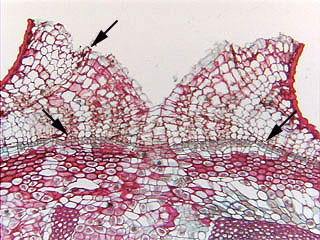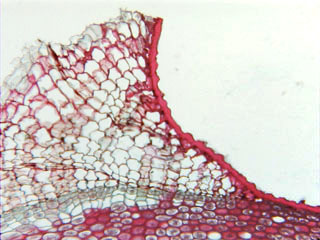 Fig.
17.3-2a and b. Transverse section of Aristolochia. The
lenticels in stem bark of Aristolochia are large, with abundant amounts
of complementary cells. Especially important, these lenticels have closing
layers – layers in which the cork cells form a somewhat tougher
sheet that holds the complementary cells in place. In the low magnification
micrograph, the upper arrow shows a mature closing layer and the two lower
arrows indicate a closing layer that is still developing.
Fig.
17.3-2a and b. Transverse section of Aristolochia. The
lenticels in stem bark of Aristolochia are large, with abundant amounts
of complementary cells. Especially important, these lenticels have closing
layers – layers in which the cork cells form a somewhat tougher
sheet that holds the complementary cells in place. In the low magnification
micrograph, the upper arrow shows a mature closing layer and the two lower
arrows indicate a closing layer that is still developing.
The
high magnification micrograph shows part of the lenticel in greater detail, but
also note two other features that it shows:
1. The
cork cambium is arising from the epidermis in this area (if your lab
has slides of Aristolochia like this, look around the slide carefully and
you will find areas where the cork cambium arises just below (interior to) the
epidermis).
2. The lenticel is forming before any other type of bark, before
layers of ordinary cork have been produced anywhere (this is not uncommon –
the little tan dots on apples (the fruits we eat, not the tree trunks) are
lenticels that form while the rest of the apple has just epidermis).